21人胚发生与早期发育
2016年上半年吉林省主治医师(计划生育)初级技师职称考试试题
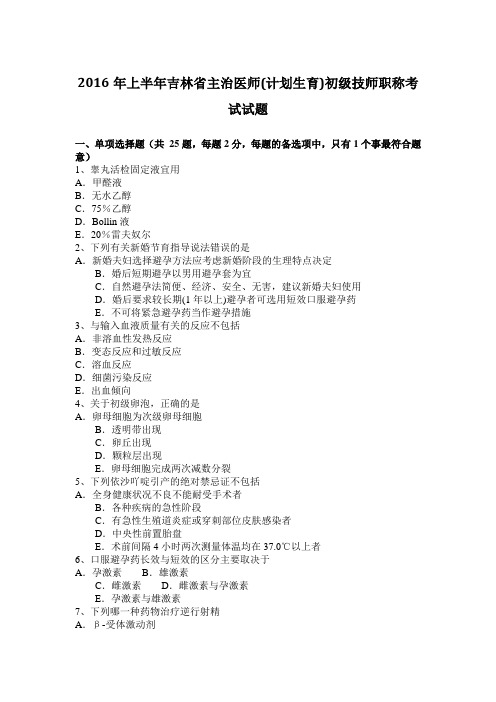
2016年上半年吉林省主治医师(计划生育)初级技师职称考试试题一、单项选择题(共25题,每题2分,每题的备选项中,只有1个事最符合题意)1、睾丸活检固定液宜用A.甲醛液B.无水乙醇C.75%乙醇D.Bollin液E.20%雷夫奴尔2、下列有关新婚节育指导说法错误的是A.新婚夫妇选择避孕方法应考虑新婚阶段的生理特点决定B.婚后短期避孕以男用避孕套为宜C.自然避孕法简便、经济、安全、无害,建议新婚夫妇使用D.婚后要求较长期(1年以上)避孕者可选用短效口服避孕药E.不可将紧急避孕药当作避孕措施3、与输入血液质量有关的反应不包括A.非溶血性发热反应B.变态反应和过敏反应C.溶血反应D.细菌污染反应E.出血倾向4、关于初级卵泡,正确的是A.卵母细胞为次级卵母细胞B.透明带出现C.卵丘出现D.颗粒层出现E.卵母细胞完成两次减数分裂5、下列依沙吖啶引产的绝对禁忌证不包括A.全身健康状况不良不能耐受手术者B.各种疾病的急性阶段C.有急性生殖道炎症或穿刺部位皮肤感染者D.中央性前置胎盘E.术前间隔4小时两次测量体温均在37.0℃以上者6、口服避孕药长效与短效的区分主要取决于A.孕激素B.雄激素C.雌激素D.雌激素与孕激素E.孕激素与雄激素7、下列哪一种药物治疗逆行射精A.β-受体激动剂B.5α-还原酶抑制剂C.α-受体激动剂D.α-受体阻滞剂E.磷酸二酯酶抑制剂8、基础体温反映A.睡眠前体温B.睡眠时体温C.机体在静息状态下的能量代谢水平D.一般活动状态下的能量代谢水平E.运动时的体温9、正常受精的部位一般发生在A.子宫体部或底部B.卵巢内C.输卵管壶腹部D.阴道穹窿E.腹腔内10、27岁初孕妇,妊娠34周,枕左前位,少量阴道流血,无宫缩,胎心140次/分。
本例最恰当的处理应是A.期待疗法B.药物引产C.立即人工破膜D.行剖宫产术E.服止血药物11、人胚的发生和早期发育是指A.受精卵形成至第6周末的胚发育过程B.受精卵形成至第7周末的胚发育过程C.受精卵形成至第8周末的胚发育过程D.受精卵形成至第9周末的胚发育过程E.受精卵形成至第10周末的胚发育过程12、关于依沙吖啶羊膜腔内注射引产穿刺点选择错误的是A.最好在B型超声引导下选择穿刺点B.尽量避开胎盘附着处C.选择囊性感最明显的部位D.在脐下两、三横指处中线两侧E.在子宫底两、三横指下方中线两侧13、男性,36岁,输精管结扎术后半年,左侧手术部位发生疼痛性结节,左侧输精管有一硬结,与精索粘连,压痛明显。
19人胚发生和早期发育《人体解剖学》《正常人体结构》《组织学与胚胎学》课件

泄殖腔膜
神经板 神经沟
神经褶
神经沟
轴旁中胚层 间介中胚层
神经沟
脊索
围心腔 胚内体腔
神经沟
轴旁中胚层 间介中胚层
神经沟 神经嵴
脊索
神经管为中枢神经系统的原基
将分化为脑和脊髓以及松果体、
神经垂体、视网膜、内耳、嗅
上皮和味觉上皮等。
神经嵴形成:神经管外侧的神经
上皮细胞不进入神经管壁,而形
成一条位于神经管背侧的细胞索,
生,形成一条纵行的细胞索,称原条。
原条的前端膨大成结节,称原结。原结 的背部凹陷,称原凹。原条的背面中线
也出现一条纵沟,称原沟。
原条的演变及退化:
时间 大小 (受精后) 13天 胚体长度的一半 22天 26天 胚体长度的1/10~ 1/5 全部消失
第15天胚盘
卵黄囊 脊索前板 羊膜 原条 体蒂
脊索 原凹 原沟 第16天胚盘
(二)植入
• 胚泡埋入子宫内பைடு நூலகம்的过程称植入,又
称着床。于受精后5 ~ 6天开始,第
11 ~12天完成。
• 通常位于子宫体部和底部。
• 植入后,子宫内膜出现蜕膜反应。蜕
膜分三部分:基蜕膜、包蜕膜和壁蜕
膜。
• 植入异常:前置胎盘和宫外孕。
名词解释
1. 何谓受精? 受精的部位? 2. 何谓植入? 植入的部位?
2.胚内中胚层形成
(1)内胚层形成:上胚层细胞增殖并通
过原条在上、下胚层之间向周边迁移。 从上胚层迁出的部分细胞进入下胚层并 逐渐全部置换下胚层细胞,形成一层新 的细胞,称内胚层。
(2)胚内中胚层形成:从上胚层迁
出的另一部分细胞则形成上、下两
胚层之间的第三层细胞,称胚内中 胚层,即中胚层。在内胚层和中胚 层出现后,上胚层即改称为外胚层。
人体胚胎发育总论
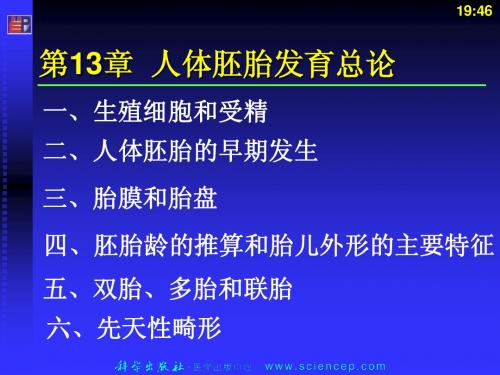
19:46
单 卵 双 胎 发 生 示 意 图
19:46
Hale Waihona Puke 联胎的种类:胸腹联胎
臀联胎
19:46
头联胎
寄生胎
19:46
头胸联体畸形
头联畸形
19:46
六、先天性畸形
• 先天性畸形是由于胚胎发育紊乱而出现的 形态结构异常 • 致畸因素----遗传因素、环境因素和环境因 素与遗传因素的相互作用 • 凡可引起先天畸形的环境因素总称为致畸 因子或致畸原 • 致畸因子包括生物性致畸因子、物理性致 畸因子、化学性致畸因子和某些药物等
19:46
二、人体胚胎的早期发生
(一)卵裂和胚泡形成 1.卵裂 受精卵早期进行的细胞分裂
第3天,卵裂球数目达12~16个,形成桑椹胚
19:46
卵裂:
19:46
1. 雌雄原核形成
2. 雌雄原核靠 近
3. 二核融合开始卵裂
4. 2细胞期
19:46
5. 4细胞期
6. 8细胞期
7. 桑椹胚
8. 早期胚泡
5.卵细胞第2次成熟分裂完成的时间( B )
A.排卵前 B.受精时 C.排卵时 D.排卵后12小时内 E.排卵后24小时内
6.植入是何结构埋入子宫内膜的过程( B )
A.胚胎 B.胚泡 C.受精卵 D.桑椹胚 E.胎儿
7.神经管是由下列何结构衍生而来的( C )
A.中胚层 D.侧中胚层 B.内胚层 C.外胚层 E.间介中胚层
胚胎学主要是研究从受精卵发育为 新生个体的过程及其机制的科学 发生过程—开始于受精卵,终于胎儿 出生,历时266天. 发育阶段:
胚期—从受精到第8周末 胎期—从第9周至出生
19:46
人胚发生和早期发育—三胚层的发生和分化(正常人体结构课件)

三胚层的分化和胚体形成 三胚层的分化 外胚层的分化
神经嵴 分化:周围神经系统
肾上腺髓质等
脑神经节 脊神经节 自主神经节 周围神经
三胚层的分化和胚体形成 三胚层的分化 外胚层的分化
外胚层 表面的细胞
分化
牙釉质、口腔和鼻腔与肛门的上皮 皮肤的表皮及其附属器
角膜上皮、晶状体、内耳膜迷路、腺垂体等
三胚层的分化和胚体形成 三胚层的分化 中胚层的分化
中胚层的分化
01 脊索两旁从内侧向外侧依次分化:
轴旁中胚层、间介中胚层和侧中胚层
02 散在分布的中胚层细胞称间充质分化:
部分结缔组织、肌组织和血管等
03 脊索的大部分:
退化消失,残留为髓核
间充质
轴旁中胚层
间介中胚层
脊索
侧中胚层
三胚层的分化和胚体形成 三胚层的分化 中胚层的分化
轴旁中胚层
轴旁中胚层
位置
分化来源:细胞滋养层细胞增殖分化
羊膜细胞 羊膜腔
胚层的形成 二胚层胚盘及相关结构的形成
二胚层胚盘相关结构
1. 羊膜腔:
位置:上胚层与滋养层之间 结构:羊水、羊膜
2. 卵黄囊:
位置:下胚层腹侧 结构:单层扁平上皮细胞
卵黄囊细胞
羊膜腔 卵黄囊
胚层的形成 二胚层胚盘及相关结构的形成
二胚层胚盘相关结构
1. 羊膜腔:
分化
背侧皮肤真皮、骨骼肌 中轴骨骼(如脊柱)
三胚层的分化和胚体形成 三胚层的分化 中胚层的分化
间介中胚层:
位置:轴旁中胚层与侧中胚层之间
间介中胚层
三胚层的分化和胚体形成 三胚层的分化 中胚层的分化
间介中胚层:
位置:轴旁中胚层与侧中胚层之间 分化:泌尿、生殖系统的主要器官
人体胚胎学
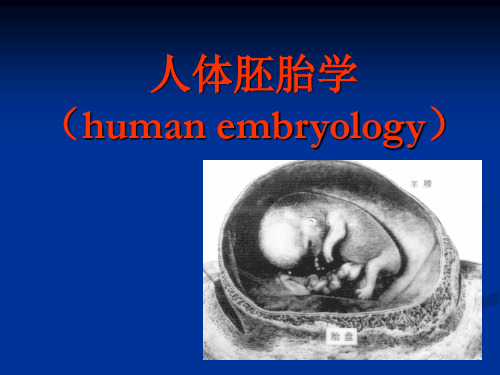
次级精母细胞 23, X
23, Y
精子细胞 23, X 23, X 23, Y 23, Y
第一次减数分裂 第二次减数分裂
精子
卵原细胞 46, XX
初级卵母细胞 46, XX
次级卵母细胞 23, X
极体 23, X
卵子 23, X 极体
23, X
图22-1. 减数分裂与配子发生过程
(二)卵子的结构
从破裂的卵泡中随卵泡液一起从卵巢排出的 卵子,是卵冠丘复合体,包括:
随胚体的卷曲而包入体内分化成原始消化管。 分化为消化管、消化腺、呼吸道、肺、膀胱、 甲状腺、胸腺等器官的上皮组织。
(四)四大组织的来源
四大组织的来源
上皮组织:三胚层 结缔组织:中胚层 肌组织: 中胚层 神经组织:外胚层
五、胚体形成和外形变化
胚盘(2周平面胚)→椭圆形胚盘→ 倒梨形(头大)→圆筒状胚(头尾接近) →初具人形。
又有与亲代不完全相同的性状,形成了物种 的多样性。 卵子激活和发育决定:受精卵旺盛代谢,不 断分裂,新个体生命产生。 决定性别。 受精的条件与生殖调控
二、胚胎的早期发生
㈠ 卵裂和胚泡形成
滋养层
受精卵 (fertilized ovum)
卵裂(cleavage)
胚泡腔 内细胞群
桑椹胚 12~16个 卵裂球(blastomere) (morula)
植入的时间:受精后5-6天开始,到11-12天完成。 部位:子宫壁的中、上部(体、底部,常见于子宫后壁)
★前置胎盘 ★异位妊娠
植入的过程:
透明带消失→极端滋养层与子宫内膜接触 →分泌蛋白酶→溶解子宫内膜→胚泡逐渐埋入 子宫内膜→胚泡全部埋入→缺口修复
植入过程中滋养层的变化:
第四章 胎儿的发育

此时出生能生存,但死亡率很高
(六)30—34周 (七)35—38周 /doc/showvideo.asp?i d=87
三、胎儿主要器官的成形时间 1.妊娠分期 早期妊娠(孕早期):妊娠12周末前 中期妊娠(孕中期):妊娠13—27周末前 晚期妊娠(孕晚期):妊娠28周以后
最早提出电热毯的生殖毒性是韦特海默 (Wertheimer),他的研究表明,电热毯产生 的低频磁场易引起人体胎儿发育不良或造成孕妇 早期流产。之后,其他研究结果发现,孕母使用 电热毯者发生胎儿生殖泌尿道畸形的危险明显增 加(OR=4.4)。而如果是在早孕阶段使用电 热毯,危险率会更高(OR=10.0),同时随着使用时 间增加,危险率也会相应提高。对0~14岁252名 被诊断为癌症的儿童的访问,证实了孕母妊娠使 用电热毯或电热床垫会增加后代的脑瘤及急性淋 巴细胞性白血病的发生率。
二、胎儿的心理 (一)听觉与记忆力 大量的生理学、心理学研究发现,孕4个月时, 胎儿的听觉系统已经建立。有人认为,孕4个月 时食物经过孕母消化道产生的肠鸣音、有节奏的 呼吸、持续节律跳动的心脏,以及每次心脏收缩 血液快速流进子宫的声音,胎儿都能听到。同时, 胎儿可听到宫外的声音。
到孕28周以后,胎儿的听觉已经发育得较好,对 于外界的声音刺激较敏感,会有喜欢或讨厌的反 应及面部表情。胎儿最喜欢、最熟悉的声音是母 亲的心跳。当胎儿听到强烈的音响如摇滚乐时会 使劲地踢脚,而听到优美舒缓的乐曲时则可安静 下来。听阈(能听到声音强度)在孕27~29周 约为40分贝。孕8个月时,胎儿能听出音调的强 弱与高低,能区别声音的种类且反应敏感(能分 辨出父亲或母亲的声音,并对较低频的父亲的声 音更敏感)。
对胎儿有害的药物:肯定毒性较大的药物 包括放射性同位素、抗癌药物、四环素; 较为肯定的药物有抗甲状腺药物、性激素、 抗凝血药物、氨基糖苷类抗生素;可能有 毒性的药物包括肾上腺皮质激素、抗癫痫 药、解热镇痛药、磺胺、氯霉素、甲硝唑 等。这些药物对胎儿毒害的影响大小,与 用药量、方法、胚胎发育时期以及胎儿基 因有关。
(完整word版)第三章 人体胚胎发育
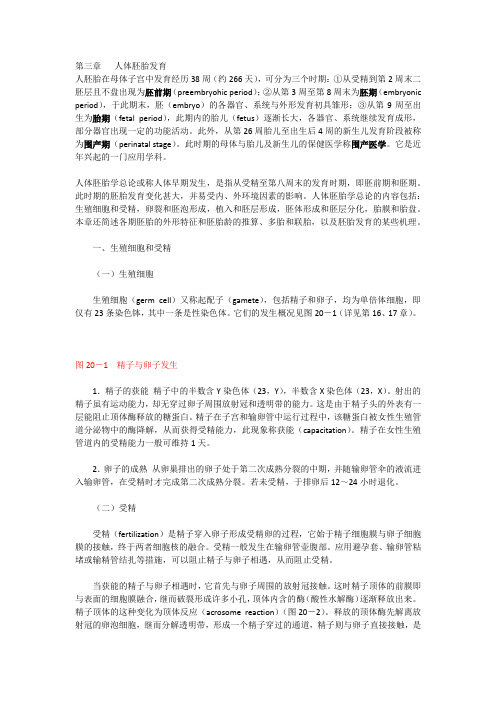
第三章人体胚胎发育人胚胎在母体子宫中发育经历38周(约266天),可分为三个时期:①从受精到第2周末二胚层且不盘出现为胚前期(preembryohic period);②从第3周至第8周末为胚期(embryonic period),于此期末,胚(embryo)的各器官、系统与外形发育初具雏形;③从第9周至出生为胎期(fetal period),此期内的胎儿(fetus)逐渐长大,各器官、系统继续发育成形,部分器官出现一定的功能活动。
此外,从第26周胎儿至出生后4周的新生儿发育阶段被称为围产期(perinatal stage)。
此时期的母体与胎儿及新生儿的保健医学称围产医学。
它是近年兴起的一门应用学科。
人体胚胎学总论或称人体早期发生,是指从受精至第八周末的发育时期,即胚前期和胚期。
此时期的胚胎发育变化甚大,并易受内、外环境因素的影响。
人体胚胎学总论的内容包括:生殖细胞和受精,卵裂和胚泡形成,植入和胚层形成,胚体形成和胚层分化,胎膜和胎盘。
本章还简述各期胚胎的外形特征和胚胎龄的推算、多胎和联胎,以及胚胎发育的某些机理。
一、生殖细胞和受精(一)生殖细胞生殖细胞(germ cell)又称起配子(gamete),包括精子和卵子,均为单倍体细胞,即仅有23条染色钵,其中一条是性染色体。
它们的发生概况见图20-1(详见第16、17章)。
图20-1精子与卵子发生1.精子的获能精子中的半数含Y染色体(23,Y),半数含X染色体(23,X)。
射出的精子虽有运动能力,却无穿过卵子周围放射冠和透明带的能力。
这是由于精子头的外表有一层能阻止顶体酶释放的糖蛋白。
精子在子宫和输卵管中运行过程中,该糖蛋白被女性生殖管道分泌物中的酶降解,从而获得受精能力,此现象称获能(capacitation)。
精子在女性生殖管道内的受精能力一般可维持1天。
2.卵子的成熟从卵巢排出的卵子处于第二次成熟分裂的中期,并随输卵管伞的液流进入输卵管,在受精时才完成第二次成熟分裂。
浙师大《发育学》课件 第八章胚胎发育与组织器官形成

人体胚胎早期发生及 组织器官的形成
• 胚胎发育:月经龄280天(40周),受精龄266天 (38周)
(围产期: 第26周胎儿~出生后4周的新生儿) 1. 胚前期:受精~第2 周末,受精卵——胚泡
2. 胚期: 第3~8周末, 二胚层——三 胚层发育及分 化为初具雏形 的胎儿
3. 胎期:第9 周~出生,胎儿生长,各系统 继续发生、发育并出现功能活动
胚体凸入羊膜腔的羊水内 原始脐带的形成 口咽膜、泄殖腔膜转到胚体头和尾的腹侧 外胚层包于胚体外表 内胚层卷到胚体内形成原始消化管 初具人形
5 - 8 周 人 胚 外 形 演 变
胚 体 形 成 及 外 形 变 化
胚体形成及外形变化
胚 体 形 成 及 外 形 变 化
胚 体 形 成 及 外 形 变 化
二 胚 层 形 成
第2周胚光镜图 (示二胚层胚盘)
第 3 周 初 胚 的 剖 面
五、胚层形成
三胚层胚盘及相关结构的形成(3W) (一)原条及中胚层的形成 1、原条:上胚层尾侧细胞增殖迁移至腹侧中轴线上, 形成的一条细胞索;(决定了胚盘中轴和头尾) 2、原沟:原条中心出现浅沟 3、原结和原窝:原条头端细胞增生形成的细胞团(原 结),其中央凹陷(原窝) 4、内胚层:原条部分细胞向深层增生内陷臵换下胚层, 而形成的新细胞层;原下胚层迁移形成卵黄囊内胚层 5、胚内中胚层:上胚层部分细胞经原条在上、内胚层 间迁移形成的新细胞层 6、外胚层:原上胚层改称 7、三胚盘:均来源于上胚层的内、中、外三胚层组成 头大尾小的梨形胚盘;(人体的原基)
上:异位植入 右下:前臵胎盘
胚泡附着于子宫内膜上皮光镜像
植 入 过 程
胚 泡 植 入 子 宫 内 膜 光 镜 像
人胚发生和早期发育

人胚发生和早期发育人胚发生和早期发育是人类生命的起源和发展过程,是医学和生物学等学科研究的重要内容之一。
在这个过程中,人的身体从无形中逐渐形成,经历了一系列的细胞分化、器官形成和生命活动的建立。
在本文中,我们将详细了解人胚发生和早期发育的过程。
人胚发生是指人类胚胎在母体内形成的过程。
人类的生命起源于受精卵,即由精子和卵子结合而成的单细胞体。
受精卵进入子宫后,会依附于子宫壁,开始通过细胞分裂和分化的过程逐渐形成胚胎。
受精卵最初分裂成细胞团,然后进一步分化为内胚层、中胚层和外胚层。
这些胚层最终分化为不同的组织和器官。
在胚胎的早期发育过程中,各种器官和系统开始形成。
最明显的例子是神经系统和循环系统的形成。
神经系统是人体的控制中心,负责感知和反应外界刺激。
在胚胎发育的早期,背嵴形成并交替成为中枢神经系统和脊柱。
脑部的形成也开始于这个时期,逐渐发展成为人体最重要的器官之一。
循环系统在人体发育的早期也开始形成。
最早的循环系统是由体腔和脉络组成的,它们在胚胎的发育过程中逐渐发展成为心脏和血管系统。
心脏在胚胎的早期就开始跳动,为胚胎提供氧气和营养物质。
随着胚胎的发育,心脏和血管系统逐渐成型,并开始输送养分和氧气到全身各个部分。
除了神经系统和循环系统,其他重要的器官和组织也在胚胎的早期发育过程中形成。
例如,消化系统和呼吸系统通过细胞分化和组织形成的过程逐渐建立起来。
消化系统负责食物的摄取和消化,呼吸系统负责气体的交换。
在胚胎发育的早期阶段,胚胎还在经历着细胞分化和胚细胞早期发育。
这个阶段胚胎的细胞开始分化为不同的组织和细胞类型,并建立起组织和器官的基本结构和功能。
同时,胚细胞逐渐发育并开始成为多个器官系统的组成部分。
总的来说,人胚发生和早期发育是人类生命的起源和发展过程,涉及到细胞分化、器官形成和生命活动的建立。
通过研究人胚发生和早期发育的过程,可以帮助我们了解人的身体结构和功能的形成,并为医学研究和生物学研究提供重要的理论和实践基础。
专业课组织学与胚胎学(人胚发生和早期发育)-试卷2
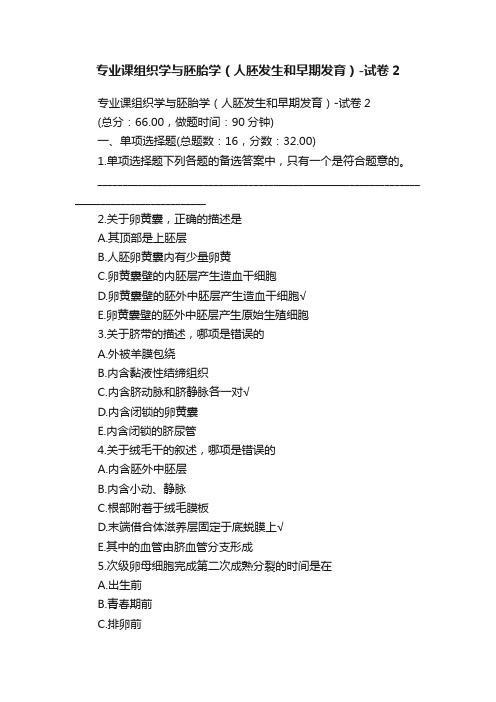
专业课组织学与胚胎学(人胚发生和早期发育)-试卷2专业课组织学与胚胎学(人胚发生和早期发育)-试卷2(总分:66.00,做题时间:90分钟)一、单项选择题(总题数:16,分数:32.00)1.单项选择题下列各题的备选答案中,只有一个是符合题意的。
________________________________________________________________ __________________________2.关于卵黄囊,正确的描述是A.其顶部是上胚层B.人胚卵黄囊内有少量卵黄C.卵黄囊壁的内胚层产生造血干细胞D.卵黄囊壁的胚外中胚层产生造血干细胞√E.卵黄囊壁的胚外中胚层产生原始生殖细胞3.关于脐带的描述,哪项是错误的A.外被羊膜包绕B.内含黏液性结缔组织C.内含脐动脉和脐静脉各一对√D.内含闭锁的卵黄囊E.内含闭锁的脐尿管4.关于绒毛干的叙述,哪项是错误的A.内含胚外中胚层B.内含小动、静脉C.根部附着于绒毛膜板D.末端借合体滋养层固定于底蜕膜上√E.其中的血管由脐血管分支形成5.次级卵母细胞完成第二次成熟分裂的时间是在A.出生前B.青春期前C.排卵前D.排卵后E.受精时√6.在胚泡植入过程中A.透明带分泌蛋白酶,溶解子宫内膜,受精卵逐渐埋入B.放射冠分泌蛋白酶,溶解子宫内膜,胚泡埋入C.桑葚胚分泌蛋白酶,溶解子宫内膜,胚泡埋入D.极端滋养层分泌蛋白酶,溶解子宫内膜,胚泡埋入√E.胚泡的内细胞群分泌蛋白酶,溶解子宫内膜,胚泡埋入7.正常植入条件中,下列哪项是错误的A.母体性激素正常分泌B.子宫内膜处于增生期√C.受精卵必须发育至胚泡D.胚泡必须准时到达子宫腔E.透明带准时消失8.体蒂属于A.外胚层B.内胚层C.胚内中胚层D.滋养层E.胚外中胚层√9.妊娠后期,胎儿生长发育于A.子宫腔B.羊膜腔√C.胚泡腔D.胚外体腔E.卵黄囊腔10.关于羊水,下列哪项是错误的A.羊膜表面的胚外中胚层分泌形成√B.足月时羊水量可达1000~1500mLC.羊水不断更新D.羊水可防止粘连E.分娩时可润滑产道,有利胎儿娩出11.内胚层不能分化形成A.胃黏膜上皮B.胰腺C.肝D.肺泡上皮E.肾小管上皮√12.肾上腺来源于A..内胚层和中胚层B.内胚层和外胚层C.中胚层和外胚层√D.中胚层E.以上都不对13.受精卵不能发育形成A.羊膜B.蜕膜√C.脐带D.绒毛膜E.胚盘14.胎儿诞生时,从剪断的脐带中流出的血液是A.胎儿的动、静脉血√B.母体的动、静脉血C.胎儿和母体的动、静脉血D.胎儿的动脉血和母体的静脉血E.胎儿的静脉血和母体的动脉血15.关于体节,描述错误的是A.由轴旁中胚层分化而来B.第5周末全部形成时共42~44对C.可分化为背侧的皮肤√D.可分化为背部的骨骼肌E.可分化形成脊柱16.导致联体双胎的原因是A.形成的两个受精卵未完全分离B.形成的两个桑葚胚未完全分离C.形成的两个胚泡未完全分离D.形成的两个内细胞群未完全分离E.一个胚盘形成的两个原条未完全分离√二、填空题(总题数:9,分数:18.00)17.填空题请完成下列各题,在各题的空处填入恰当的答案。
【精品医学】专业课组织学与胚胎学(人胚发生和早期发育)-试卷2

26.神经嵴是神经板外侧缘细胞迁移到神经管背侧形成的纵行细胞索,是周围神经系统的原基。 (分数:2.00)
A.正确 √ B.错误 解析: 27.卵黄囊是造血干细胞和原始生殖细胞发生的部位。 (分数:2.00) A.正确 √ B.错误 解析: 28.胎盘由母体的底蜕膜和胎儿的丛密绒毛膜构成。 (分数:2.00) A.正确 √ B.错误 解析: 29.胚胎发育早期,绒毛膜分为平滑绒毛膜和丛密绒毛膜两种类型。 (分数:2.00) A.正确 B.错误 √ 解析: 30.胎盘分泌的人绒毛膜促性腺激素具有促进母体黄体生长、维持妊娠的作用。 (分数:2.00) A.正确 √ B.错误 解析: 31.由一个胚泡内出现两个内细胞群发育形成的两个胚胎,位于一个羊膜腔内,共享一个胎盘。 (分数:2.00) A.正确 B.错误 √ 解析: 32.中胚层既可以形成结缔组织、肌组织、骨组织,又可以形成上皮组织。 (分数:2.00) A.正确 √ B.错误 解析: 33.整个妊娠期,孕妇体内具有较高水平的人绒毛膜促性腺激素,故子宫内膜 (分数:2.00) A.正确
B.错误 √ 解析:
解析: 16.导致.形成的两个受精卵未完全分离 B.形成的两个桑葚胚未完全分离 C.形成的两个胚泡未完全分离 D.形成的两个内细胞群未完全分离 E.一个胚盘形成的两个原条未完全分离 √ 解析:
二、 填空题(总题数:9,分数:18.00)
17.填空题请完成下列各题,在各题的空处填入恰当的答案。(分数:2.00) __________________________________________________________________________________________ 解析: 18.如果一个胚泡内出现两个_______,各自形成一个胚胎,它们有各自的_______,但是共用一个_______,发 育成的两个胚胎称为_______。 (分数:2.00) __________________________________________________________________________________________ 正确答案:(正确答案:内细胞群;羊膜腔;胎盘;单卵孪生) 解析: 19.胚胎早期,整个绒毛膜表面绒毛均匀分布,之后,_______侧的绒毛膜血供匮乏,绒毛退化消失,形成表面 无绒毛的_______。_______侧的血供充足,绒毛生长茂密,称_______。 (分数:2.00) __________________________________________________________________________________________ 正确答案:(正确答案:包蜕膜;平滑绒毛膜;底蜕膜;丛密绒毛膜) 解析: 20.绒毛膜由_______和衬于其内表面的_______组成。植入完成后,前者又进一步分化为_______和_______两 层。由这两层结构形成的突起称为_______。 (分数:2.00) __________________________________________________________________________________________ 正确答案:(正确答案:滋养层;胚外中胚层;细胞滋养层;合体滋养层;初级绒毛干) 解析: 21.男性生殖管道排出的精子具有_______能力,但无受精能力,精子在通过女性生殖管道过程中,获得受精能 力的反应称为_______。 (分数:2.00) __________________________________________________________________________________________ 正确答案:(正确答案:运动;精子获能) 解析: 22.中枢神经系统的原基是_______,来自_______胚层;泌尿、生殖系统的原基是_______,来_______胚层; 消化和呼吸系统的原基是_______,来自_______胚层。 (分数:2.00) __________________________________________________________________________________________ 正确答案:(正确答案:神经管;外;间介中胚层;中;原始消化管;内) 解析: 23.胎盘由胎儿的_______和母体的_______共同构成,其_______面光滑,表面覆有_______,_______面粗糙, 可见 15~30 个_______,胎盘主要具有_______和_______的功能。 (分数:2.00) __________________________________________________________________________________________ 正确答案:(正确答案:丛密绒毛膜;底蜕膜;胎儿;羊膜;母体;胎盘小叶;物质交换;内分泌) 解析: 24.人胚第 3 周,上胚层一端细胞在中央部分增殖形成一条细胞索,称为_______,它的出现使胚盘有了_______ 侧和_______端之分。 (分数:2.00) __________________________________________________________________________________________ 正确答案:(正确答案:原条;左右;头尾) 解析:
2021临床医学 胚胎发育-胚胎早期发育-胎膜与胎盘

胎膜受精卵分裂分化形成的细胞,一部分发育为胎儿;另一部分发育为胚体以外的结构,称胎膜。
胎膜是一些临时性的器官,对胚体有营养、保护等作用。
胎膜有羊膜、卵黄囊、尿囊、脐带和绒毛膜(图1-9)。
图1-9 胎膜模式图1 羊膜羊膜为一层半透明无血管的薄膜,由羊膜上皮和胚外中胚层组成。
早期附着于胚盘的边缘,后来附着于脐带的基部。
羊膜腔开始很小,以后随胚体的发育逐渐扩大,至第2021羊膜在部分和绒毛膜相贴,小部分包在脐带的表面。
羊膜腔内充满羊水,胎儿在羊水中生长发育图1-10。
羊水由羊膜上皮的分泌物和胎儿的排泄物组成。
胎儿5个月后能吞饮大量羊水,使羊水不断更新。
早期羊水为淡黄色透明的液体,较粘稠。
后期羊水渐混浊。
足月时羊水的量有1000ml左右。
若少于500ml为羊水过少,常因胎儿无肾或尿道闭锁所致;多于2021ml为羊水过多,常因胎儿食管闭锁或无脑畸形所致。
羊水对胎儿有保护作用,可缓冲外力的直接压迫和震荡,防止肢体粘连,分娩时羊水可扩张宫颈,冲洗产道,有助于胎儿的娩出。
羊水中除含少量的蛋白质、葡萄糖、多种酶和激素、无机盐、尿素外,还有胎儿脱落的上皮细胞。
测定羊水中蛋白质的含量和酶的缺失,或作细胞的核型分析,可预测胎儿性别和诊断胎儿某些遗传性疾病及先天性畸形。
图1-10 羊膜2 卵黄囊随着胚体的发育,卵黄囊顶部的内胚层被卷入胚体内,形成原肠,卵黄囊与原肠相连的部分形成卵黄蒂。
第6周末卵黄蒂闭锁并与原肠断离。
卵黄囊逐渐萎缩退化成一个小泡,残存在胎盘的脐带附着处图1-9。
卵黄囊壁的胚外中胚层发生血岛,是胚胎原始造血干细胞的发生地和最早的造血场所。
原始生殖细胞也来自卵黄囊壁的内胚层。
人的卵黄囊内无卵黄,是人类进化中的一个遗迹器官。
3 尿囊尿囊是卵黄囊顶部尾侧内胚层突入体蒂内的一个盲管图1-9。
在人类也是进化上的一个遗迹器官。
但其壁上的血管将演变成脐血管,尿囊根部参与膀胱的形成。
4 脐带随着胚体向腹侧包卷和羊膜腔的扩大,羊膜把体蒂及其中的尿囊、尿囊血管和卵黄蒂等都挤到胚体的腹面,形成一条圆柱状的结构,称脐带图1-9。
人的胚胎发育

人的胚胎发育摘要个体发育是指多细胞生物体从受精卵开始,经过细胞分裂、组织分化、器官形成,直到性成熟等过程。
该过程可以分为两个阶段,即胚胎发育和胚后发育。
胚胎发育是指从受精卵发育到成熟的胎儿的过程。
胚胎发育包括受精卵(0~1天),卵裂(1~3天),囊胚(4天),原肠胚(7~12天),胚胎前期(13~60天)和胎儿(61~280天)。
关键词:受精卵,卵裂,囊胚,原肠胚,胚胎前期,胎儿1.受精卵1.1受精:成熟获能后的精子与卵子结合成受精卵的过程,称为受精。
一般发生在输卵管壶腹部。
正常成年男性一次射精可射出3亿~5亿个精子,其中300 ~500个最强壮的精子能到达输卵管壶腹,但最终只有一个精子能与卵子结合。
1.2受精过程精卵相会就是形成受精卵。
这个过程就是受精的过程。
受精过程约需24小时。
当一个获能的精子进入一个次级卵母细胞的透明带时,受精过程即开始。
到卵原核和精原核的染色体融合在一起时,则标志着受精过程的完成。
1.3受精过程①精子穿过放射冠;②精子穿过透明带;③精、卵质膜融合,细胞核融合。
精子的进入激发卵子完成第二次成熟分裂,这时精子和卵子的细胞核分别称为雄原核和雌原核,二者在细胞中部靠拢染色质混合,形成受精卵,即合子。
2.卵裂受精卵形成后立刻开始向子宫方向运行,一边进行细胞分裂。
由于子细胞被透明带包裹,在分裂间期无生长过程,仅原受精卵的胞质不断分到子细胞中,故随着细胞数的增加,细胞体积不断变小。
受精卵这种特殊的有丝分裂称卵裂。
产生的子细胞,称卵裂球。
受精后第三天,卵裂球达12~16个,共同组成一个实心的细胞团,外观如桑椹,故称桑椹胚。
桑椹胚细胞继续分裂,但卵裂球达100个左右时,细胞间出现若干小的腔隙,逐渐融合为一个大腔,腔内充满液体。
此时透明带开始溶解,胚呈现为囊泡状,故称为胚泡。
由滋养层和内细胞群构成。
3. 囊胚随着胚胎的进一步发育,胚胎的内部开始出现了含有液体的囊胚—囊胚腔,这个时期的胚胎叫做囊胚。
胚胎学概论

(1)获能精子接
内容物扩散至细胞表面和
近卵冠丘复合体
透明带,阻止多精受精。
受精过程模式图
受精的基本条件
发育正常并已 获能的精子与 发育正常的卵 子在限定的时 间相遇 。
意义 物种延续:标志新个体的产生;
合子更富有活力:恢复了二倍体,维
持物种的稳定性;使双亲遗传物质重组下传;
决定胎儿性别:
受精后,母体血浆内很快出现一种免疫 抑制物,称早期妊娠因子,它是目前检 测早期妊娠的一种指征。
间介中胚层:形成泌尿生殖系统。 侧中胚层:其脏层形成形成消化、
呼吸系统的肌组织、CT;壁层形 成体壁骨骼、肌肉和CT;胚内体 腔分隔成心包腔、胸膜腔和腹膜 腔。 间充质:分化为结缔组织、血管等。
1、精子成熟、获能:精子 在女性生殖道内头部的糖 蛋白被分解而获得受精能 力的现象称之获能。精子 在女性生殖管道内的受精 能力一般可维持1天。
2、卵子成熟:从卵巢排 出的卵子处于第二次成 熟分裂的中期,并随输 卵管伞的液流进入输卵 管,在受精时才完成第 二次成熟分裂。若未受 精 、 于 排 卵 后 12 ~ 24 小 时退化。
体壁中胚层
脏壁中胚层
前神经孔
中肠
体腔 体腔
神经管
心脏 心包腔 c. 第25天 脊索
泄殖腔膜
背主动脉
原始消化管
侧折 羊膜
脑 口咽膜 卵黄囊
泄殖腔膜
脏壁中胚层
卵黄蒂
A. 胚横切面
d. 第28天 B. 胚正中矢状切面
体蒂
胚层分化与胚体形成过程模式图
中胚层分化
轴旁中胚层(体节):形成皮肤真皮、 中轴骨骼及骨骼肌。
中胚层
1、轴旁中胚层 2、间介中胚层 3、側中胚层
计划生育主治医师考试:2021计划生育基础知识真题模拟及答案(5)
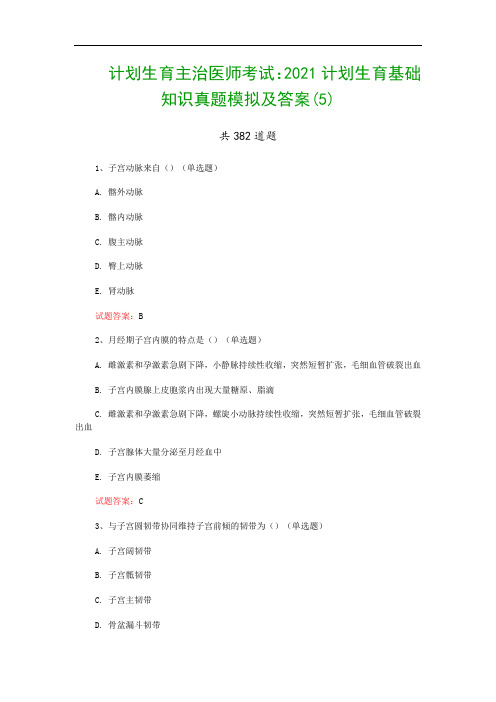
计划生育主治医师考试:2021计划生育基础知识真题模拟及答案(5)共382道题1、子宫动脉来自()(单选题)A. 髂外动脉B. 髂内动脉C. 腹主动脉D. 臀上动脉E. 肾动脉试题答案:B2、月经期子宫内膜的特点是()(单选题)A. 雌激素和孕激素急剧下降,小静脉持续性收缩,突然短暂扩张,毛细血管破裂出血B. 子宫内膜腺上皮胞浆内出现大量糖原、脂滴C. 雌激素和孕激素急剧下降,螺旋小动脉持续性收缩,突然短暂扩张,毛细血管破裂出血D. 子宫腺体大量分泌至月经血中E. 子宫内膜萎缩试题答案:C3、与子宫圆韧带协同维持子宫前倾的韧带为()(单选题)A. 子宫阔韧带B. 子宫骶韧带C. 子宫主韧带D. 骨盆漏斗韧带E. 卵巢固有韧带试题答案:B4、关于输精管的描述,错误的是()(单选题)A. 睾丸部位于阴囊内B. 精索部介于睾丸上端和腹股沟外环之间C. 精索部和腹股沟部参与精索组成D. 在膀胱底后面末段膨大为输精管壶腹E. 与前列腺的排泄管汇合成射精管试题答案:E5、阴囊壁的构成除皮肤外,还有()(单选题)A. 肉膜B. 睾丸鞘膜壁层C. 白膜D. 提睾筋膜E. 睾丸鞘膜脏层试题答案:A6、男性红细胞数目和血红蛋白含量通常高于女性是由于()(单选题)A. 男性喜欢运动B. 男性摄入更多的蛋白质C. 男性体内红细胞破坏减少D. 男性通常摄入更多的铁E. 男性体内雄激素的浓度高试题答案:E7、人类的造血干细胞来自()(单选题)A. 卵黄囊壁的胚外中胚层B. 羊膜上皮和胚外中胚层C. 绒毛膜的滋养层D. 绒毛膜的胚外中胚层E. 细胞滋养细胞试题答案:A8、下列说法正确的是()(单选题)A. 人工授精分为夫精人工授精和供精人工授精B. 体外受精-胚胎移植的适应证包括母儿血型不合不能得到存活新生儿C. 卵胞浆内单精子注射适用于男方或家族有不宜生育的严重遗传性疾病D. 植入前遗传学诊断主要用于鉴定性别E. 我国目前允许使用卵细胞胞浆置换或卵细胞核移植技术试题答案:A9、卵原细胞进入第一次减数分裂,并静止于前期双线期,改称为初级卵母细胞是开始于()(单选题)A. 胚胎7~8周B. 胚胎11~12周C. 胚胎16~20周D. 妊娠30~32周E. 妊娠37~40周试题答案:B10、分化泌尿生殖系统的大部分器官的部分是()(单选题)A. 外胚层B. 中胚层D. 上胚层E. 下胚层试题答案:B11、胎盘的功能不包括()(单选题)A. 代谢功能B. 防御功能C. 合成功能D. 免疫功能E. 羊水吸收试题答案:E12、受精的必备条件不包括()(单选题)A. 精子必须成熟和获能B. 精子必须发育正常和有足够的数量C. 卵子必须完成第二次成熟分裂D. 精子和卵子必须在限定的时间内相遇E. 男女生殖道必须畅通且功能正常试题答案:C13、尿道穿过尿生殖膈的部分是()(单选题)A. 尿道球部B. 尿道海绵体部C. 尿道前列腺部D. 尿道膜部E. 尿道外口14、关于月经的特点下述各项正确的是()(单选题)A. 有排卵才有月经B. 排卵发生在两次月经之间C. 月经期基础体温是上升的D. 排卵发生在下次月经来潮前14天E. 排卵发生在月经来潮后第14天试题答案:D15、医疗机构从业人员行为规范适用人员包括()。
专业课组织学与胚胎学(人胚发生和早期发育)-试卷1.doc

专业课组织学与胚胎学(人胚发生和早期发育)-试卷1(总分:66.00,做题时间:90分钟)一、单项选择题(总题数:16,分数:32.00)1.单项选择题下列各题的备选答案中,只有一个是符合题意的。
(分数:2.00)__________________________________________________________________________________________2.受精大多位于(分数:2.00)A.输卵管峡部B.输卵管壶腹部C.输卵管漏斗部D.子宫底或体部E.输卵管子宫部3.下列哪项不属于胚泡的结构(分数:2.00)A.滋养层B.胚泡液C.胚泡腔D.内细胞群E.放射冠4.植入后的子宫内膜称(分数:2.00)A.胎膜B.蜕膜C.羊膜D.绒毛膜E.基膜5.形成原条的是(分数:2.00)A.下胚层细胞B.上胚层细胞C.中胚层细胞D.胚外中胚层细胞E.滋养层细胞6.中胚层不能分化形成(分数:2.00)A.平滑肌B.卵巢C.疏松结缔组织D.肾E.假复层纤毛柱状上皮7.外胚层、中胚层和内胚层均起源三(分数:2.00)A.胚内中胚层B.下胚层C.上胚层和下胚层D.胚外中胚层E.上胚层8.人胚初具雏形的时间是(分数:2.00)A.第4周末B.第6周末C.第8周末D.第12周末E.第16周末9.透明带消失于(分数:2.00)A.排卵时B.受精时C.卵裂开始时D.胚泡植人前E.桑葚胚时期10.宫外孕最常发生的部位在(分数:2.00)A.卵巢表面B.子宫阔韧带C.肠系膜D.输卵管E.膀胱壁11.形成胚内体腔的是(分数:2.00)A.内胚层B.外胚层C.间介中胚层D.侧中胚层E.体节12.下列哪项不是胎盘的特点(分数:2.00)A.盘状,母体面粗糙,胎儿面光滑B.由母体子宫底蜕膜和胎儿平滑绒毛膜构成C.是母体与胎儿进行物质交换的场所D.通过胎盘膜进行物质交换E.有内分泌功能,可以产生人绒毛膜促性腺激素等激素13.将绒毛固定于母体底蜕膜上的是(分数:2.00)A.合体滋养层B.细胞滋养层壳C.体蒂D.胚胎隔E.胚外中胚层14.胚泡开始植入的时间相当于月经周期的(分数:2.00)A.第9~10天B.第12~14天C.第16~17天D.第20~21天E.第27~28天15.诱导神经板形成的是(分数:2.00)A.间介中胚层B.原条C.原节D.体节E.以上都不对16.胎盘的绒毛间隙内含有(分数:2.00)A.组织液B.胎儿血浆和母体血浆C.胎儿血液和母体血液D.胎儿血液E.母体血液二、填空题(总题数:10,分数:20.00)17.填空题请完成下列各题,在各题的空处填入恰当的答案。
第三章 人体胚胎发育

第三章人体胚胎发育人胚胎在母体子宫中发育经历38周(约266天),可分为三个时期:①从受精到第2周末二胚层且不盘出现为胚前期(preembryohic period);②从第3周至第8周末为胚期(embryonic period),于此期末,胚(embryo)的各器官、系统与外形发育初具雏形;③从第9周至出生为胎期(fetal period),此期内的胎儿(fetus)逐渐长大,各器官、系统继续发育成形,部分器官出现一定的功能活动。
此外,从第26周胎儿至出生后4周的新生儿发育阶段被称为围产期(perinatal stage)。
此时期的母体与胎儿及新生儿的保健医学称围产医学。
它是近年兴起的一门应用学科。
人体胚胎学总论或称人体早期发生,是指从受精至第八周末的发育时期,即胚前期和胚期。
此时期的胚胎发育变化甚大,并易受内、外环境因素的影响。
人体胚胎学总论的内容包括:生殖细胞和受精,卵裂和胚泡形成,植入和胚层形成,胚体形成和胚层分化,胎膜和胎盘。
本章还简述各期胚胎的外形特征和胚胎龄的推算、多胎和联胎,以及胚胎发育的某些机理。
一、生殖细胞和受精(一)生殖细胞生殖细胞(germ cell)又称起配子(gamete),包括精子和卵子,均为单倍体细胞,即仅有23条染色钵,其中一条是性染色体。
它们的发生概况见图20-1(详见第16、17章)。
图20-1精子与卵子发生1.精子的获能精子中的半数含Y染色体(23,Y),半数含X染色体(23,X)。
射出的精子虽有运动能力,却无穿过卵子周围放射冠和透明带的能力。
这是由于精子头的外表有一层能阻止顶体酶释放的糖蛋白。
精子在子宫和输卵管中运行过程中,该糖蛋白被女性生殖管道分泌物中的酶降解,从而获得受精能力,此现象称获能(capacitation)。
精子在女性生殖管道内的受精能力一般可维持1天。
2.卵子的成熟从卵巢排出的卵子处于第二次成熟分裂的中期,并随输卵管伞的液流进入输卵管,在受精时才完成第二次成熟分裂。
- 1、下载文档前请自行甄别文档内容的完整性,平台不提供额外的编辑、内容补充、找答案等附加服务。
- 2、"仅部分预览"的文档,不可在线预览部分如存在完整性等问题,可反馈申请退款(可完整预览的文档不适用该条件!)。
- 3、如文档侵犯您的权益,请联系客服反馈,我们会尽快为您处理(人工客服工作时间:9:00-18:30)。
---significance of fertilization: 1) a new life begin(initiation of cleavage) 2)restoration of the diploid number of
chromosomes: cross-over 3) determination of the sex of the new individual:
---decidual response of endometrium /stroma cell→predecidual cell→decidual cell(cell become larger and rich in glycogen and lipid droplet)
/endometrium →decidua: -decidua basalis -decidua capsularis -decidua parietalis
---processes of fertilization: 1) acrosome reaction: /hyaluronic acidase: dissolve corona radiate * interact with ZP3(receptor glycoprotein, exist in zona pellucide) molecules, release /acrosin: dissolve zona pellucide /enter perivitelline space
---conditions: 1) maturation of oocyte 2) maturation of spermatozoon: /ductus epididymus: 2-3 weeks, motility protein
forward
3) capacitation of spermatozoa:
decapacitation factor: exist in epididymus, to inhibit the release of acrosome enzymes
capacitation factor: secreted by epi. cells of oviduct, capacity of releasing acrosome enzymes
组织胚胎学课件
七年制英文医学班专用
中国医科大学
基础医学院
组胚—英文教学组
Chapter 21
General Embryology
---a science which study the processes and regulations of development of human fetus.(from 1 cell(zygote) to (5-7)X1012 cells )
1) cleavage and blastocyst formation ①cleavage ---blastomere: cells formed by cleavage /30h: 2 /40h: 4 /72h: 12-16- morula
②formation of blastocyst: by 5th day, blastomere reach to 107, small space appear between them
1.Fertilization
---definition: the process by which the male and female gametes(sperm and ovum) unite to give rise to zygote
---place: in the ampullary region of the fallopian tube
---blastocoele: filled with liquid
---trophoblast
---inner cell mass
---polar trophoblast
2) Implantation
---definition: the process by which the blastocyst is embedded in endometrium
4) quality and quantity of spermatozoa: 2-6 ml, 100,000,000/ml, <1.5 ml; or <10,000,000; abnormal sperm >30%; or capacity for mobile< 70%
5) meeting of sperm and ovum sperm: 20-24h ovum: 15-18h(1-3ds)
ova(22+X) + X-bearing spermatozoon = girl ova(22+X) + Y-bearing spermatozoon = boy *klinefelter’s syndrome: 47XXY, 48XXXY
2. Blastocyst formation and implantation
---mesoderm: intraembryonic mesoderm
---endoderm: hypoblast cells are replaced by epiblast cells
---ectoderm: epiblast changed the name into ectoderm
* trilaminar germ disc: endoderm + mesoderm + ectoderm
---epiblast: primary ectoderm /amniotic membrane: amnioblast /amniotic cavity /amniotic fluid /amnion
---hypoblast: primary endoderm
/extraembryonic endoderm→exocoelomic membrane→primary yolk sac → exocoelomic vesicle
2) formation of mesoderm: early of 3 weeks ---primitive streak: cells of epiblast proliferate to
form a longitudinal arranged cell cord ---primitive groove ---primitive node ---primitive pit
zona reaction: change of ZP3 molecules in zona pellucide
4) formation of zygote(fertilized ovum)
secondary meiosis complete: form second polar body
male pronucleus fuse with female pronucleus, to restore the 2n chromasome
2) spermatozoa fuse with the membrane of ovum: nucleus enter cytoplasm of ovum
3) monospermy:
cortical reaction: cortical granules(located in cytoplasm of ovum) are released into perivitelline space, and cause
① differentiation of ectoderm: from 18th –19th days ---neural plate: neuro-epithelium(neural ectoderm):
pseudostratified columnar epi. ---neural fold ---neural groove ---neural tube: →CNS
---time: 5th –6th day begin; 11th –12th day complete
---processes: zona pellucide disappear → polar trophoblast touch the endometrium→secrete proteolytase →dissolve the endometrium → embedded into endometrium→coagulation plug seal the come into two layers when blastocyst is embedding into endometrium syncytiotrophoblast cytotrophoblast
---place: /posterior wall of fundus and body of uterus placenta praevia ectopic pregnancy
---differentiation: same cells which are primordial and inmuture differentiate into different cells which have specific structure and function
---induction: some tissues effect the differentiation, and determine the differentiating orientation of another tissue
